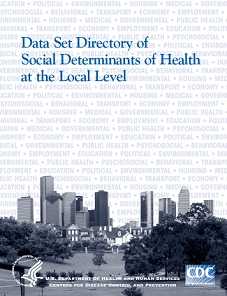Data Set Directory of Social Determinants of Health at the Local Level

The contents of this directory are adapted from the following article: Hillemeier M.M., J. Lynch, S. Harper, and M. Casper. 2003. "Measuring contextual characteristics for community health." Health Services Research 38(6 part 2):1645–717.
Introduction
There is widespread interest in the role of social health determinants at the local level. Federal, state, and local government agencies, academic institutions, and community organizations are increasingly recognizing the need to understand and address the socioeconomic contexts; such as, where people work and play to improve their health and welfare. There is renewed emphasis on implementing interventions to improve socioenvironmental conditions. Such interventions have the potential to produce wide–ranging health benefits (see the April 2003 supplement of the American Journal of Preventive Medicine) and could reduce marked health disparities that remain a high–priority for public health (USDHHS 2000). It is critical that decisions to improve health and eliminate health disparities are integrated into community characteristics that promote or endanger health. Recent interest around the country is the need for improved conceptual data on how the social environment impacts the health of populations (Pickett and Pearl 2001; Macintyre and Ellaway and Cummins 2002; Yen and Syme 1999; Kaplan and Lynch 1997, 2001; Diez Roux 2004; Berkman 2004; Krieger and Davey Smith 2004; Institute of Medicine 1997; M. Miringoff and M.L. Miringoff 1999; Howell et al. 2003).
This Data Set Directory of Social Determinants of Health at the Local Level is a response to those needs. The directory contains an extensive list of existing data sets that can be used to address these determinants. The data sets are organized according to 12 dimensions, or broad categories, of the social environment. Each dimension is subdivided into various components.
This directory was a project based at the University of Michigan School of Public Health and funded by the Centers for Disease Control and Prevention (CDC). Investigators from the United States and Europe were invited to a workshop to review an initial list of dimensions important for understanding social determinants of health. Participants represented a wide range of disciplines including epidemiology, sociology, geography, medicine, demography, economics, developmental psychology, education, and toxicology. Others with interests and expertise in community contextual characteristics on health were also invited, including government experts on data sources and geographic information systems, public health practitioners, and experts on community consultation and processes.
Structured discussions among the workshop participants led to consensus on a core set of 12 dimensions. Participants then generated detailed lists of components within each dimension, along with suggestions for possible data sources and specific variables that might be used to measure the dimension components. The results of the workshop, the lists of components, and data indicators were refined by the University of Michigan staff, taking into consideration both conceptual relevance and availability of appropriate data at the local level. An extensive search for data sets that address each of the dimensions and components was conducted—including both traditional and nontraditional sources. The search results are presented in this directory.
We focused primarily, but not exclusively, on data sets that contain information for Metropolitan Statistical Areas (MSAs). We chose to focus on MSAs primarily because there is a broad range of data for MSAs that is routinely collected and geographically coded. We recognize, however, that there is no single ideal level for measuring social health determinants in relationship to health–damaging and health–promoting factors. In fact, different characteristics may operate at different levels. An argument can be made that using more localized units, such as county, zip code, census tract, and census block, increases the likelihood of measuring certain aspects of the social and physical environment actually experienced by individuals. Considerably more detailed contextual data sources are available for larger units such as states. Given the inevitable trade–offs between data availability and proximity to lived experience, we chose to focus on MSAs.
Top of Page- Page last reviewed: March 13, 2014
- Page last updated: July 23, 2013
- Content source:



 ShareCompartir
ShareCompartir